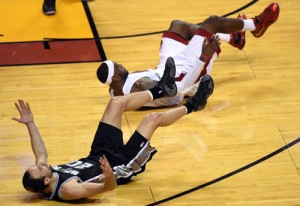MIAMI: Just think about this statistic.
The San Antonio Spurs played nearly an entire quarter without missing a shot. That’s right, the Spurs didn’t hear a “clank” for 11 minutes.
It was the most telling number in the Spurs regaining control with a 111-92 victory against the Miami Heat on Tuesday in Game 3 of the NBA Finals. They lead 2-1 in the best-of-7 series, heading into Thursday’s Game 4 at American Airlines Arena.
“They came out at a different gear than what we were playing at,” Heat coach Erik Spoelstra said. “It just seems we were on our heels most part of the first half . . . You have to give them credit for coming out with an aggressive mind set on both ends.”
LeBron James and Dwyane Wade each scored 22 points to lead the Heat, who shot a respectable 51 percent from the field. It just the Spurs, led by Kawhi Leonard’s 29 points, were that much better.
The awesome display of offensive efficiency was highlighted by a first half for the ages. The Spurs shot an absurd 86 percent in the first quarter and opened by making 19 of 21 shots. They finished 38 of 64 (59 percent) from the field.
“I don’t think we’ll shoot 76 percent in a half ever again,” Spurs coach Gregg Popovich said. “ . . . That’s crazy.”
And the Heat thought things were hot when the air-conditioning malfunctioned in the series-opener at AT & T Center? No, their defenders were sweating even more trying to find a way to slow the Spurs’ offense.
The Heat trailed 41-25, with the Spurs becoming the first Finals team to score at least 40 points in one quarter since the 2008 Boston Celtics. The defining moment of the game began after Spurs forward Tim Duncan missed a shot with five minutes, five seconds left in the first quarter.
The next miss didn’t occur until guard Tony Parker’s 3-point attempt was off with 6:45 left . . . in the first half.
In between, the Spurs made 11 consecutive field goals.
By then, the outcome was already decided.
“You can’t win a championship with that kind of effort, home or away,” Heat center Chris Bosh said. “ . . . We did nothing right and we deserve what we have.”
The Spurs in the process made their path to a fifth championship less difficult. Had they lost, they would have been faced with the task of needing to defeat the Heat in consecutive games at some point to win the series.
The Heat have not lost back-to-back post-season games since the 2012 Eastern
Conference finals against the Celtics, a string of 47 games.
It was evident the Spurs would eliminate that challenge when they led by many as 25, forcing the Heat to play from behind most of the way. The Heat kept the fans from headed for the exits early by outscoring the Spurs 25-15 in the third quarter.
A Norris Cole layup with 1:54 left made it a seven-point game. With most of the run occurring with James on the bench, the Heat had every reason to believe a comeback was possible.
There were a couple brief spurts to provide suspense.
Heat guard Ray Allen hit a 3-pointer to make it 90-80 with 8:54 left, prompting the Spurs to call timeout. The Spurs responded with a 7-2 run, highlighted by a Leonard dunk and Danny Green 3-pointer.
The loss puts the Heat in a similar situation as last year. After the teams split a pair of close games, the Spurs won big in Game 3. The question now is will the series play out the same way. The teams traded blowout victories before the Heat won two thrillers to win the championship.
“It’s a long series,” Spoelstra said. “We have to be able to manage this. It starts with [Wednesday] owning it. That will be the process we have to go through together.”
For the Spurs on Tuesday, it was all about adjustment. They spent the past two days figuring out how to improve ball movement after it failed them in the second half of the Game 2 loss. A switch in the starting line-up was just the spark needed to improve spacing.
Popovich went with Boris Diaw at center instead of Tiago Splitter. Without Splitter clogging the middle, the Spurs had much better offensive rhythm. It led to more scoring coming within the offense.


